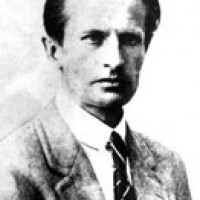Eggeling was born on October 21, 1880 in Sweden to a family of German descent. At seventeen, after his parents died, he immigrated to Germany. He worked as an accountant and later studied painting and art history. He spent the period between 1911 and 1915 in Paris as an independent artist. When WW II began, he moved to Switzerland where he collaborated with the group called
Generalbaß der Malerei, whose members attempted to develop a form of painting which corresponded with music. At that time he met Hans Richter, Jean Arp, Tristan Tzara and Marcel Janc. At the end of the WW II he and Richter returned to Germany where they started researching the idea of movement, first in paintings and later in film. In 1921, he ended his collaboration with Hans Richter and began researching new trends in film. He worked on the now lost ten-minute film
Horizontal-Vertical-Orchestra, which he never finished. He had good contacts with Russian artists and German Constructivists, and in 1923 he met Erna Niemeyer who helped him with his next film
Diagonalsinfonie. The first private screening of that film was held on November 5, 1924. It was publicly shown on May 3, 1925 as part of the famous matinee program
Novembergruppe. Sixteen days later Viking Eggeling died.

